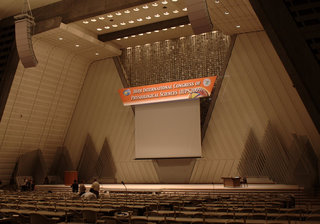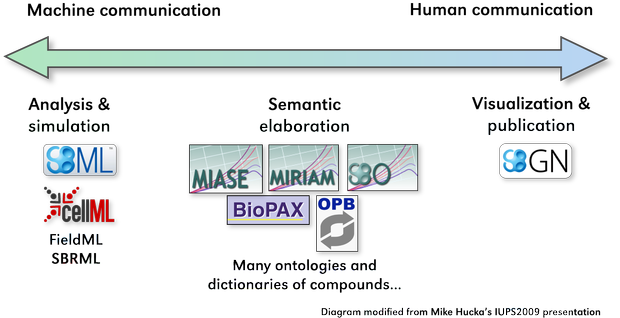IUPS 2009 report
More pictures from IUPS2009
Several members of the ABI CellML team attended the 2009 IUPS meeting in Kyoto, Japan from the 27th of July to the 1st of August. Two talks in particular were of interest to the CellML team. The first was presented by Professor Peter Hunter from the Auckland Bioengineering Institute, who talked about the Physiome Project, and the second was given by Dr Mike Hucka from Caltech, as an extension of his talk from the satellite meeting.
The notes below were taken by members of the CellML team and are subject to personal interpretation. If you have any corrections to make please contact us and we will be happy to incorporate them.
The Physiome Project
Professor Peter Hunter, Auckland Bioengineering Institute
The Physiome Project is primarily about structure-function relations. Peter began his talk with an introduction to the concept of multi-scale modelling and presented the idea that there are 10 main challenges associated with this task:
- Clinical applications – The justification for the reseach and oftern the source of research funding. In the longterm we are looking towards personalised models and population scale databases. In the less distant future, the aim is to get to the clinical trial level.
- Coupling physics across all the processes occuring in an organ - For example in the heart, this involves coupling heart mechanics, with cardiac circulation, and electrophysiology.
- Model reporoducibility – There is a need to ensure that published models can be reproduced. To facilitate this reproducility a published model should be associated with i) minimal requirements of information (MIRIAM), ii) be written in a standard format (eg CellML, FieldML, SBML, etc.), iii) be annotated with ontological terms (eg from SBO, FMA, GO, OPB, etc.), and to reproduce a simulation there needs to be information encoded in MIASE, SEDML and KISAO (for example). Model respositories such as the CellML Model Reposiory and the BioModels Database represent part of the solution towards model reproducibility.
- Model reduction for multiscale modelling – “Modelling is an art”. Model complexity needs to be reduced when applied to large, multiscale frameworks for the sake of the model simulation speed.
- Model synthesis – How can we facilitate the process of model reconstruction? One solution maybe to create libraries of annotated modular components. These libraries would be searchable, such that the modules of interest can be easily found and then combined to form larger, more complex models.
- Error analysis – parameter sensitivity and confidence limits have to be considered.
- The gap between the models in bioengineering and systems biology needs to be closed.
- Genotype-phenotype mapping needs to take place.
- Structural stability – cell-to-cell heterogeneity needs to be considered in the models.
- Mechanisms for collaboration – International collaboration is required for both model and software development. We also need to think about how young researchers are to be rewarded, in an academic environment where traditionally published papers are the measure of success. In the present environment how are software development and the sharing of models in public databases to be rewarded?
An overview of several standardization efforts for systems biology
Dr Michael Hucka, California Institute of Technology
Like Peter, Mike began his presentation by introducing the problem – in this case, the need for a standard model description format to faciliate model exchange. SBML is one potential solution to this problem.
Mike went on to briefly discuss the main features of SBML, and highlighted the fact that there are now more than 170 tools available for editing and simulating SBML models; a considerable increase since the project started in 2000. In part this success can be attributed to libSBML – a free library written in many languages and available on several different platforms, which allows developers to build their own SBML-compliant tools.
- SBO – Systems Biology Ontology – Used to annotate a model with additional information. SBO is aimed at annotating the maths, not the biology. It adds semantic inforamtion to a model.
- MIRIAM – Minimum Information Requested In the Annotation of biochemical Models – Adds information such as model provenance.
- MIASE - Minimum Information About a Simulation Experiment – Captures the simulation information that is needed to recreate a published figure (information which is needed in addition to the core model description). Such information might include the type of simulation, initial conditions, simulation duration, are the axes log scale?, etc. MIASE is used together with SEDML – the underlying format needed to express MIASE.
- SBGN – Systems Biology Graphical Notation – Engineering and software development already have a standard visual language. By contrast biological diagrams vary greatly between textbooks and journals – even between publications by the same author. This can lead to confusion when interpreting the diagrams. SBGN is a standard set of glyphs used to represent biological entities and processes. Already there are 17 tools which support SBGN.
In conclusion, all of this is a large, international, community effort involving many different people and research groups. Communication is essential to maintain this collaboration. Every year there is one SBML meeting and one SBML hackathon, plus other ad hoc workshops.




